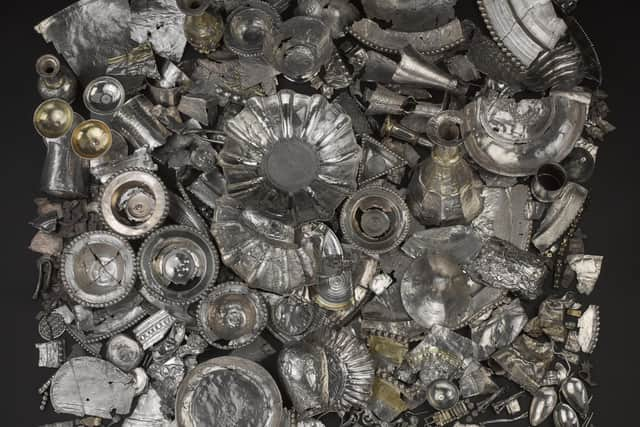Shedding new light on some of Scotland's greatest Roman silver treasures - Dr Fraser Hunter
What new things can we learn about such a well-known find, you might ask? As it turns out, a lot. The original publication about the Traprain Treasure was written by the excavator, Alexander Curle, within four years of the discovery, an impressive achievement.
What one man did in four years has taken an international team over a decade to revise. A core group of scholars from Switzerland, Germany, France and the UK has worked tirelessly on the finds, drawing in contributions from other colleagues, including many current and former staff of National Museums Scotland. Our publications team laboured long and hard to bring it to fruition through the challenges of the pandemic.
Advertisement
Hide AdAdvertisement
Hide AdWe have contemporary benefits that Curle didn’t have, most significantly the power of modern scientific analysis. Our analytical scientist Lore Troalen, working with Janet Lang of the British Museum, scrutinised the silver with a dazzling array of technologies which would have seemed like science fiction to Curle. These include high-powered microscopes, X-rays and particle beams to tease out more information on its composition and manufacture.
The silver has remarkably high purity, averaging 96% silver content. The Roman state took care to keep its silver at a good quality. Thanks to the scanning electron microscope, we can scrutinise every tool-stroke of the craftsman, marvelling at their skill and precision.
But where were these vessels made? This has always been a difficult problem to solve. Craftsmen shared styles across the Empire, and the Roman elites who owned the silver travelled widely.
To investigate this we sampled solder, the lead-tin ‘glue’ used to fix handles and fittings onto vessels. Roland Schwab, then of the Curt-Engelhorn-Zentrum Archäometrie in Mannheim, analysed the lead isotopes to fingerprint likely sources. This showed that the solder in the five vessels we sampled was not from the Mediterranean but from the north-west provinces, either around Cologne or the Pennines. Our next step, once we raise the funding, is to analyse the silver itself. It was extracted from lead, whose residual traces will be enough to fingerprint it – a tantalising future prospect.
The vast majority of silver in the Roman world was used for elite dining vessels, or did service in the bathing and beauty regimes of powerful Roman women. Using silver was a major social statement. Among the remarkable variety of vessels, you can find fragments that once came from a huge silver dish over 700mm in diameter. There’s also one of the earliest Christian items known from Scotland, a wine jug decorated with scenes from the Old and New Testament.


More personal items are rare, but there are a few belt fittings and a single brooch. There are also five silver coins, battered from long use. They’ve been deliberately cut down, preserving the face of the emperor to maintain a ‘face value’ but removing clippings to make into additional fresh coins. In the early fifth century, after the Roman world turned its back on Britain, the residual government in the south was desperately trying to keep a monetary economy running by any means. This hoard takes us into and beyond the death-throes of Roman Britain.
There seemed no doubt when it was found that it was the work of raiders from beyond the weakened empire who plundered it, relieved it of its wealth, and chopped this fine classical art to pieces. Our work tells a different story.
I spent more time than is sensible staring at every fragment, trying to establish how it was cut up and assessing its weight. There are clear patterns. Vessels were initially cut up quite carefully and regularly to standard Roman weights, suggesting they were transformed into bullion within the Roman world. This most likely occurred at times of economic stress when people needed ready, transportable wealth rather than large, clumsy dishes.
Advertisement
Hide AdAdvertisement
Hide AdMany pieces were then hacked again, and again, and again, with no concern for Roman weight standards. It suggests a long life to the pieces, cut first by Romans then moving beyond the frontier, perhaps as payment for mercenaries or as ‘gifts’ to buy peace. The people on Traprain Law seem to have been friends of Rome for centuries. This silver came to a place well-accustomed to Roman gifts.
Our work also showed that this was a long-term phenomenon. The silver reached Traprain in multiple episodes over more than a hundred years, not in one big bang. The earliest pieces were made around AD 300, the latest around 450. This was no single hoard, but a treasure built up over generations of contact with the Roman world and their neighbours.
We don’t know why the hoard was buried and never recovered. It was placed in the yard of some pretty ordinary-looking buildings on the west side of the hill, with no sign that this was the home of a leader or a metal-worker, for instance. It was probably buried to keep it safe, and for some reason the owner never returned. This seems to have been a personal tragedy rather than a wider one, since settlement continued on the hill for a good fifty years or more. But the silver slumbered from its burial around 450 until its rude awakening in 1919.
Dr Fraser Hunter is principal curator of Iron Age and Roman collections at National Museums Scotland
-The Late Roman Silver Treasure from Traprain Law, edited by Dr Fraser Hunter, Dr Annemarie Kaufmann-Heinimann and Dr Kenneth Painter, published by National Museums Scotland, is available now.